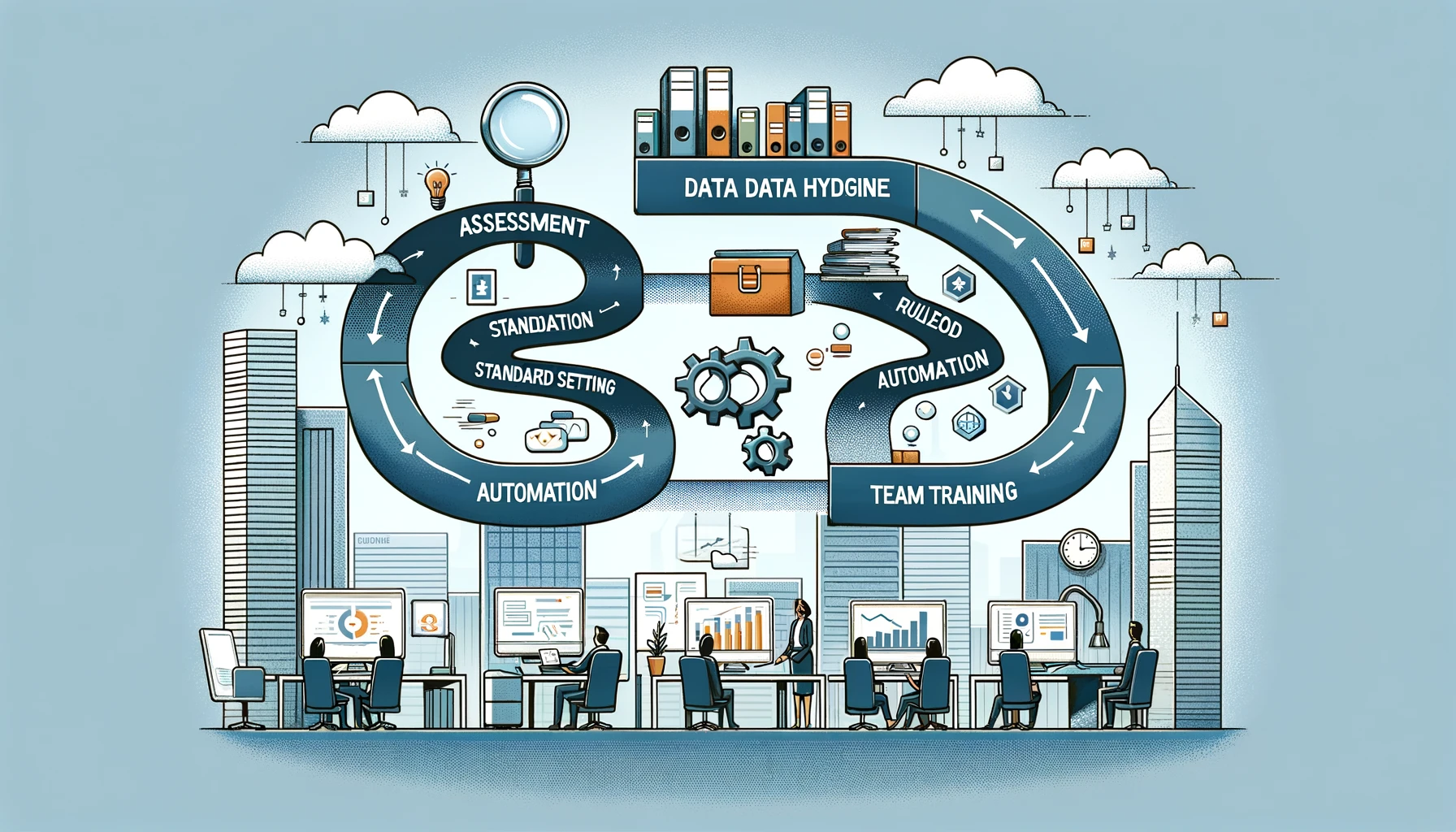Data Hygiene Essentials: Elevate Your Data Quality for Success
Unlock the secrets to pristine data with our guide on data hygiene, ensuring accuracy and boosting your business's decision-making process.
Part 1. Data Hygiene Essentials: Elevate Your Data Quality for Success
Part 2. Data Hygiene Services: Elevate Your Data Quality and Compliance
Part 3. Data Hygiene Tools: Enhance Your Data Quality and Accuracy
Part 4. Data Hygiene Best Practices: Elevate Your Data Quality Today
Part 5. What is Data Hygiene: Essential Practices for Data Quality
Unlocking the Benefits of Data Hygiene Best Practices
When it comes to managing your company’s data, cleanliness is next to effectiveness. Embracing data hygiene best practices isn’t just about tidying up; it’s about unlocking a world of benefits that can propel your business forward. Let’s dive into how maintaining pristine data can be a game-changer.
Firstly, high-quality data is the backbone of informed decision-making. With accurate and up-to-date information at your fingertips, you can trust your analytics and insights, leading to smarter strategies and a competitive edge. Moreover, it streamlines operations, reducing time spent correcting errors and chasing down the right information.

But what exactly does a clean data set look like? Think reduced redundancies and increased consistency—qualities that enhance your CRM efficiency and customer engagement. By ensuring your team has access to the best quality data, you’re also empowering them to provide top-notch service.
To quantify the impact, consider the following comparison:
| Metric | Before Implementation | After Implementation | Improvement |
|---|---|---|---|
| Data Accuracy (%) | 75 |
98 |
+30.7% |
| Lead Conversion Rate (%) | 15 |
25 |
+66.7% |
| Customer Retention (%) | 80 |
90 |
+12.5% |
| Operational Efficiency (%) | 60 |
85 |
+41.7% |
By adopting these practices, you’re not just cleaning up data; you’re setting the stage for continued growth and success. Remember, when your data is in top form, so is your business. Let’s keep the momentum going and uncover even more ways to enhance your data hygiene regimen in the following sections.
The Fundamentals of Data Cleaning and De-duplication
Data cleaning and de-duplication are essential to maintaining a lean, effective database. By regularly scrubbing data, you remove inaccuracies that could derail your analytics efforts. It’s about ensuring that every entry in your system is both accurate and necessary, eliminating costly redundancies.

Imagine a garden. Just as you would weed out the unnecessary to help the desirable plants thrive, data de-duplication weeds out duplicate entries to let your database’s performance flourish. It’s a simple concept with profound impacts on your customer management and marketing strategies.
Here’s a step-by-step breakdown to guide your process:
| Step | Description |
|---|---|
| Identify Redundancies | Spot duplicate or irrelevant data entries. |
| Validate Data | Confirm data accuracy and relevance. |
| Standardize Entries | Ensure consistency across all data points. |
| Remove Duplicates | Delete or merge redundant entries. |
| Monitor and Maintain | Regularly check for and remove new duplicates. |
By applying these steps, you not only polish your database but also enhance your operational efficiency. It’s a proactive approach to data management that can save you time and money while boosting the reliability of your insights.
Harnessing Data Accuracy for Competitive Advantage
In today’s data-driven market, harnessing data accuracy provides a substantial competitive advantage. Accurate data fuels precise targeting and personalization, helping your company stand out. Think of it as the compass guiding your business to uncharted territories of opportunity and growth.
Maintaining data accuracy isn’t just a one-time fix; it’s an ongoing commitment. Regular audits and validations ensure that your data remains a reliable source for strategic decisions. This commitment translates to customer trust and loyalty as they recognize your company’s dedication to quality and detail.

Consider this: A mere 5% increase in data accuracy can lead to improved lead generation and a significant uptick in conversion rates. And when it comes to customer relations, accurate data means personalized experiences that resonate, fostering a deeper connection with your audience.
Below is a snapshot of how data accuracy can elevate various business facets:
| Benefits of Data Accuracy | Impact on Business |
|---|---|
| Enhanced Target Marketing | Increased ROI |
| Streamlined Customer Service | Higher Satisfaction Levels |
| Informed Strategic Decisions | Steady Business Growth |
As you refine your data hygiene practices, keep in mind that the path to accuracy is an investment in your company’s future. With a steadfast approach to data quality, you’re paving the way for enduring success.
Real-World Success Stories of Impeccable Data Hygiene
Discover how impeccable data hygiene can transform businesses. In the real world, companies that prioritize data cleanliness not only thrive—they lead. For instance, a leading retail chain experienced a 20% surge in marketing campaign effectiveness after revamping its data hygiene approach, leading to increased sales and customer loyalty.

Another success story comes from the healthcare sector, where a hospital network adopted stringent data hygiene protocols. The result? A dramatic 40% reduction in patient record errors and a significant boost in healthcare outcomes. These examples underscore the tangible benefits of investing in data hygiene, from heightened efficiency to improved customer satisfaction.
Embrace these best practices, and your company could be the next data hygiene success story. Clean data is not an option; it’s a necessity for staying ahead in today’s fast-paced business environment.
A Step-by-Step Guide to Implementing Data Hygiene Protocols
Implementing data hygiene protocols is crucial for any business looking to leverage data effectively. Begin by setting clear standards for data entry to prevent errors at the source. Next, schedule regular clean-ups to catch and correct any inaccuracies that slip through. Training your staff on these protocols is essential, as their adherence to these practices will determine the quality of your data.

Here’s a concise guide to get you started:
| Step | Description |
|---|---|
| Develop Data Entry Guidelines | Create clear rules for how data should be entered. |
| Schedule Routine Clean-Ups | Regularly review and correct data sets. |
| Train Your Team | Ensure everyone understands the importance of data hygiene. |
| Audit and Refine | Continually assess the effectiveness of your protocols. |
| Leverage Technology | Use software to automate and streamline the process. |
Adopting these steps can significantly enhance your data management and ensure that your decisions are powered by clean, reliable data. Remember, the quality of your data can be the difference between success and stagnation.
FAQs
What is data hygiene and why is it important?
Data hygiene refers to the collective processes involved in ensuring the cleanliness, accuracy, and consistency of data within a database or dataset. Good data hygiene is crucial because it ensures that data is reliable and can be used effectively for analysis, decision-making, and operations. Poor data hygiene can lead to errors, misinformed decisions, and inefficiencies.
What are the key practices for maintaining good data hygiene?
Key practices for maintaining good data hygiene include regularly cleaning and de-duplicating data, validating and updating information, standardizing data entry processes, and ensuring secure storage and handling of data. It also involves implementing clear policies for data management and training staff on best practices.
How often should data be cleaned and validated?
The frequency of data cleaning and validation depends on the nature of the data and how often it is being updated or used. For dynamic databases with frequent changes, data should be cleaned and validated regularly, such as weekly or monthly. For more static data, a quarterly or bi-annual schedule may suffice. It is also important to perform data hygiene checks after data migrations or integrations.
Can you explain what de-duplication means in the context of data hygiene?
De-duplication in data hygiene refers to the process of identifying and removing duplicate records within a dataset. Duplicate data can occur due to multiple entries, errors in data entry, or merging of datasets. De-duplication ensures that each piece of data is unique and that the dataset is not inflated with redundant information, which can skew analysis and reporting.
What role does staff training play in data hygiene?
Staff training is a critical component of data hygiene because it ensures that all team members understand the importance of data accuracy and consistency. Training helps staff to follow standardized data entry procedures, recognize the signs of data quality issues, and take the necessary steps to maintain data integrity. Investing in regular training can significantly reduce the risk of data errors and improve overall data quality.




